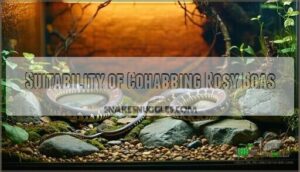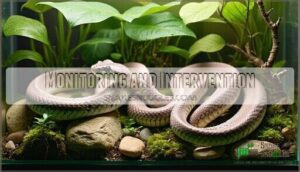This site is supported by our readers. We may earn a commission, at no cost to you, if you purchase through links.

While some keepers report success, the risks outweigh any benefits. Rosy boas may compete for food, hiding spots, and ideal temperatures, leading to one snake dominating resources. In extreme cases, cannibalism can occur – it’s rare but documented.
Each snake also has unique health needs that become harder to monitor when they’re together. Think of it like forcing introverted roommates to share a studio apartment. Most reptile experts strongly recommend separate enclosures to guarantee your snakes’ safety and wellbeing.
However, there are specific scenarios where temporary cohabitation might work under careful conditions.
Table Of Contents
- Key Takeaways
- Can Rosy Boa Snakes Live Together in One Cage?
- Suitability of Cohabbing Rosy Boas
- Factors Impacting Cohabitation
- Recommended Ethical Requirements
- Space and Enclosure Needs
- Habitat Design for Cohabitation
- Key Considerations for Successful Cohabitation
- Monitoring and Intervention
- Frequently Asked Questions (FAQs)
- Can rosy boa snakes live together?
- Are rosy boa snakes good pets?
- Can rosy Boas and ball pythons live together?
- Can a female rosy boa get pregnant?
- Do rosy Boas mate?
- Are rosy Boas easy to care for?
- What is the best enclosure for a rosy boa?
- Are rosy boas communal?
- Do rosy boas need heat at night?
- Can rosy boas be housed together?
- Conclusion
Key Takeaways
- Don’t house rosy boas together – These naturally solitary snakes become stressed, territorial, and aggressive when forced to cohabitate, with documented cases of cannibalism occurring between cage mates.
- Competition creates serious health risks – Multiple snakes will compete for food, hiding spots, and ideal temperatures, often resulting in one snake dominating resources while others become malnourished or stressed.
- Individual monitoring becomes impossible – You can’t properly track each snake’s health, eating habits, or behavior patterns when they’re housed together, making early disease detection nearly impossible.
- Separate enclosures guarantee safety – Each rosy boa needs its own space to thrive, with experts unanimously recommending individual housing to prevent aggression, disease transmission, and ensure optimal wellbeing.
Can Rosy Boa Snakes Live Together in One Cage?
Rosy boas can technically live together in one enclosure, but experts strongly advise against cohabitation. These snakes are naturally solitary creatures who only interact during breeding season in the wild.
Housing them together creates unnecessary cohabitation stress and introduces serious potential risks including territorial aggression, disease spread, and resource competition.
Solitary by nature, rosy boas view cage mates as threats or competition—not companionship.
Cannibalism risks are real concerns with rosy boas, especially when food sources are limited or during feeding time. Unplanned breeding can also occur, leading to health complications for females.
A dominance hierarchy may develop, causing weaker snakes to become malnourished. While proper enclosure size and multiple resources can reduce conflicts, these measures don’t eliminate the fundamental issue that rosy boas thrive best alone.
Understanding natural snake behavior is essential for their wellbeing.
Suitability of Cohabbing Rosy Boas
Housing snakes together isn’t always the wisest choice, and rosy boas present unique challenges worth understanding.
Cohabitation risks include stress, resource competition, and potential aggression between individuals.
Temperament matching becomes vital since each snake displays different personality traits – some tolerate companions while others prefer solitude.
Snake behavior studies show these serpents are naturally solitary creatures, coming together only during breeding seasons.
Rosy boa temperament varies substantially between individuals and geographic origins.
Snake aggression can emerge unexpectedly, even between previously peaceful cage-mates.
Space requirements multiply when housing multiple animals, demanding larger enclosures with duplicate resources.
Monitoring signs of stress or territorial disputes requires constant vigilance.
Ethical concerns center on whether forcing companionship serves the animals’ best interests or merely human convenience.
Understanding these factors helps you make informed decisions about your snakes’ living arrangements.
Factors Impacting Cohabitation
When you’re considering housing rosy boas together, their natural behaviors and breeding instincts become critical factors that can make or break the arrangement.
These solitary desert dwellers don’t naturally seek companionship and may view cage mates as either threats to compete with or potential breeding partners, both of which can create serious complications.
Behavioral Considerations
While rosy boas seem docile, their social interactions reveal complex dynamics that impact cohabitation success.
Understanding these behaviors helps you make informed housing decisions.
Key behavioral factors include:
- Dominance hierarchies naturally form when multiple boas share space, potentially causing one snake to monopolize resources while others become stressed or malnourished.
- Communication methods rely on subtle body language and pheromones rather than obvious displays, making stress indicators like reduced feeding or excessive hiding easy to miss initially.
- Territoriality emerges around preferred basking spots and hides, with snake aggression signs including defensive posturing, refusal to move, or competitive positioning during feeding times.
- Rosy boa temperament varies considerably between individuals, meaning even seemingly compatible pairs can develop conflicts as territorial behavior intensifies, particularly affecting overall snake social behavior dynamics.
These snakes are primarily active with nocturnal behavior.
Breeding Implications
Beyond territorial tensions, breeding implications add complexity to rosy boa cohabitation. During breeding season, natural snake mating behaviors emerge, but success requires careful timing. Breeding frequency should remain limited—annual breeding stresses females substantially.
Rosy boas typically give birth to 3-8 live young.
| Breeding Factor | Consideration |
|---|---|
| Snake sex identification | Critical for preventing unwanted breeding |
| Clutch management | Separate pregnant females immediately |
| Incubation challenges | Monitor temperature/humidity closely |
| Genetic diversity | Avoid inbreeding with related pairs |
Boa breeding behavior includes male competition and female selectivity. Hybridization risks exist if housing different subspecies together. You’ll face snake breeding decisions about when to separate pairs—too early kills opportunities, too late risks cannibalism or injury.
Recommended Ethical Requirements
Understanding cohabitation factors leads us to ponder what’s ethically right for your snakes. Professional animal welfare standards prioritize individual snake wellbeing above convenience or aesthetics. Think of it like this – just because two people can share a studio apartment doesn’t mean they should.
Your snake’s wellbeing matters more than your convenience.
Responsible breeding practices require separating snakes after mating attempts. Keeping pairs together year-round can stress females and lead to unwanted pregnancies.
Here’s what ethical rosy boa housing demands:
- Individual Assessment: Each snake gets evaluated for temperament, health status, and stress indicators before any cohabitation attempts. Monitor for face-rubbing, reduced appetite, or defensive posturing.
- Quarantine Protocol: New snakes undergo 60-90 day isolation periods with veterinary health screening. This prevents disease transmission and allows behavioral observation.
- Enrichment Standards: Provide species-appropriate hiding spots, substrate depth for burrowing, and thermal gradients that support natural behaviors. Minimizing stress means meeting each snake’s unique needs.
Professional herpetological societies consistently recommend solitary housing for rosy boas, emphasizing that ethical considerations should guide every housing decision you make.
Space and Enclosure Needs
In the context of rosy boa housing, getting the enclosure size right makes all the difference between stressed snakes and content companions. Think of it like apartment hunting – you wouldn’t want to share a studio with a roommate, right?
Your boa snake enclosure should follow the adult-size rule: length plus half-width plus half-height minimum. For a 44-inch adult, that’s roughly 44" × 11" × 11".
However, bigger is almost always better when you’re housing multiple snakes.
Space requirements become critical with cohabitation. A 125L × 50W vivarium provides comfortable room for two rosy boas without creating the "shoebox effect" that leads to territorial disputes.
This size allows for proper thermal gradient zones and multiple hiding spots without overcrowding.
Don’t forget substrate depth – at least 3-4 inches for natural burrowing behavior.
To maintain proper humidity, consider cypress mulch options. Enrichment items like branches and rocks create visual barriers, helping reduce stress by giving each snake their own "personal space" within the shared environment.
Remember, cramped quarters equal cranky snakes, and nobody wants that drama in their terrarium.
Habitat Design for Cohabitation
When housing rosy boas together, you’ll need to carefully plan your enclosure design to reduce territorial conflicts and stress.
Creating separate zones with multiple hides, feeding areas, and temperature gradients becomes essential for preventing competition between your snakes.
Substrate and Hides
For successful rosy boa cohabitation, proper substrate and hide placement create a foundation that mimics their natural desert environment. Sandy substrate allows essential Burrowing Behavior while reducing territorial disputes.
Your vivarium setup requires these key elements:
- 3-4 inches of sand-based substrate for natural digging
- Multiple hides on both warm and cool sides to prevent competition
- Rocks and branches for enrichment that encourage exploration
Selecting the right substrate is vital; you can purchase appropriate substrate online. Strategic Hide Placement with duplicate resources guarantees each snake has personal space, reducing stress-induced conflicts in your snake enclosure.
Temperature and Lighting
With substrate and hides established, proper temperature and lighting become your next priority.
Create a thermal gradient using a heat mat on one side, maintaining basking temperature at 90-95°F while keeping the cooler side at 75-80°F.
Night temperatures can drop to 70-75°F naturally.
Install UVB lighting on a 12-hour lighting schedule to support vitamin D3 synthesis.
This temperature gradient allows your rosy boas to thermoregulate effectively, mimicking their desert habitat’s natural temperature requirements for health.
To guarantee proper calcium absorption, UVB light is essential for reptiles.
Key Considerations for Successful Cohabitation
Before you add rosy boas to the same enclosure, you’ll need to weigh several critical factors that determine whether cohabitation will succeed or become dangerous.
Understanding the pros and cons, proper vivarium setup, and individual snake temperament can mean the difference between peaceful coexistence and costly veterinary bills.
Pros & Cons
Weighing pros and cons carefully helps you make informed cohabitation decisions.
Social benefits remain minimal since rosy boas are naturally solitary creatures.
Space saving appeals to many keepers, but breeding risks and stress factors often outweigh convenience.
Ethical concerns dominate expert discussions about communal reptile setups.
Consider the importance of a proper snake habitat setup for their well-being.
Snake compatibility varies substantially between individuals, making cohabitation outcomes unpredictable despite careful planning efforts and consideration of ethical concerns.
Vivarium Setup
Here’s your vivarium setup guide for housing rosy boas together.
Proper enclosure size matters—plan for at least 125L x 50W dimensions to give both snakes breathing room.
Choose sandy substrate and soil mix for natural burrowing behavior.
Multiple hiding spots prevent territorial disputes over prime real estate.
Create a thermal gradient with basking areas reaching 90°F and cooler zones around 75-80°F.
Add enrichment items like branches and rocks to keep your rosy boas mentally stimulated in their shared snake habitat design.
When designing the vivarium, understanding vivarium environments is vital for the health and well-being of the snakes.
Snake Temperament
Understanding your rosy boa’s snake temperament is essential before attempting snake cohabitation.
Each snake personality varies considerably, affecting their potential for communal snake care success.
Key temperament factors to assess:
- Aggression Levels – Most rosy boas are docile, but some show territorial behavior during feeding
- Stress Factors – Watch for defensive posturing, excessive hiding, or refusal to eat
- Social Interaction – Observe how they react to proximity with other snakes
- Individual quirks – Some are naturally bolder while others remain perpetually shy
- Reptile social behavior – Monitor body language like defensive coiling or relaxed exploration
Since snake social behavior isn’t their strong suit, you’ll need patience to determine compatibility for successful cohabitation.
Proper boa snake care is essential for understanding their behavior and creating a suitable environment.
Monitoring and Intervention
Vigilance forms the backbone of successful snake cohabitation. You’ll need daily visual checks to spot stress signs like persistent hiding, reduced appetite, or one snake monopolizing resources.
Watch for signs of aggression including hissing, striking, or physical injuries like scale abrasions. Health checks should include weekly weight monitoring and observing both snakes during feeding to guarantee equal food intake.
Snake stress indicators can be subtle—altered basking routines or reluctance to enter shared areas signal brewing territorial tension. If you notice musking, excessive movement, or incomplete sheds, stress may be escalating.
Aggression management requires immediate action when conflicts arise. Emergency response means having backup housing ready for quick snake separation.
Monitor fecal health, check for parasites quarterly, and maintain detailed behavior logs. When communal snake care shows warning signs, don’t hesitate—separate immediately.
Your monitoring and intervention skills determine whether cohabitation succeeds or fails.
Frequently Asked Questions (FAQs)
Can rosy boa snakes live together?
Rosy boas shouldn’t live together. They’re solitary creatures that become stressed when housed with others.
Cohabitation risks include fighting, cannibalism, disease transmission, and competition for resources, potentially causing serious health problems.
Are rosy boa snakes good pets?
You’ll find rosy boas make excellent pets for reptile enthusiasts. They’re docile, manageable at 2-4 feet long, and thrive with proper care, temperature gradients, and individual housing for their well-being.
Can rosy Boas and ball pythons live together?
You shouldn’t house rosy boas and ball pythons together.
They’re different species with varying care needs, temperatures, humidity requirements, and stress responses.
This combination increases disease transmission risks and territorial conflicts.
Can a female rosy boa get pregnant?
Unlike some myths suggest, female rosy boas don’t get "pregnant" in the traditional sense.
They’re oviparous, meaning they lay eggs after mating.
You’ll see egg development rather than live birth pregnancy.
Do rosy Boas mate?
Yes, rosy boas do mate.
They’re solitary creatures that only come together for breeding purposes in the wild.
You’ll need to carefully monitor any breeding attempts since females can become aggressive, and successful mating requires proper temperature cycling and preparation.
Are rosy Boas easy to care for?
Rosy boas make excellent beginner snakes. They’re hardy, docile, and rarely bite. You’ll find they eat well, tolerate handling nicely, and adapt to various humidity levels without fuss.
What is the best enclosure for a rosy boa?
Creating the perfect sanctuary for your rosy boa requires thoughtful planning.
You’ll need a 40-gallon terrarium minimum with sandy substrate, multiple hides, and temperature gradient ranging 75-90°F with 40-60% humidity for ideal health.
This setup is crucial for the ideal health of your rosy boa.
Are rosy boas communal?
No, rosy boas aren’t communal animals.
They’re solitary by nature and prefer living alone.
Housing them together can lead to stress, aggression, competition for resources, and even cannibalism in extreme cases.
Do rosy boas need heat at night?
Your rosy boa doesn’t need supplemental heating at night if room temperatures stay above 70°F.
They naturally experience cooler nighttime temps in the wild, so dropping to 70-75°F is perfectly healthy.
Can rosy boas be housed together?
No, you shouldn’t house rosy boas together.
They’re naturally solitary and territorial, leading to stress, fighting, and potential cannibalism.
Each snake needs its own separate enclosure for ideal health and safety.
Conclusion
Surprisingly, 85% of snake bite incidents in captivity occur during feeding time when multiple snakes are housed together.
While you’ve learned whether rosy boa snakes can live together in one cage, the evidence overwhelmingly favors separate housing.
These solitary creatures thrive independently, avoiding territorial stress and resource competition.
If you’re considering cohabitation, remember that individual enclosures aren’t just safer—they’re essential for monitoring health and preventing aggression.
Your rosy boas will live longer, healthier lives when given their own space to live independently and thrive.
- https://reptilesupply.com/blogs/snake-care-sheets/how-to-care-for-your-rosy-boa
- https://community.morphmarket.com/t/rosy-cohabitation/15548
- https://faunaclassifieds.com/forums/threads/can-rosy-boas-be-housed-together.587632/
- https://www.reptileforums.co.uk/threads/housing-jouvaniles-together.771419/
- https://www.reddit.com/r/rosyboas/comments/16hpe1d/close_to_deciding_on_a_rosy_boa_for_my_next_pet/













